Hello and welcome to ‘Focused on Feld’. In my Focused on Feld series of reviews, I am working my way through Stefan Feld’s entire catalogue. Over the years, I have hunted down and collected every title he has ever put out. Needless to say, I’m a fan of his work. I’m such a fan, in fact, that when I noticed there were no active Stefan Feld fan groups on Facebook, I created one of my own.
Today we’re going to talk about 2017’s Merlin, his 26th game.
Overview
King Arthur is getting old. Seeing that his days are numbered he, along with Merlin, has begun searching for a worthy successor to his throne. In the game of Merlin, designed by Stefan Feld and Michael Rienick, players take on the roles of Knights of the Round Table as they vie to earn their king’s favor. As the players construct manors in the environs, repel traitors, complete quests, and wield their influence in the kingdom’s principalities, they will rise ever higher in the dying king’s eyes. In the end, the player who has earned the most favor will emerge victorious as the new King of England.
If you’re more interested in what I think about Merlin and less interested in how the game is played, then feel free to fast forward to the Thoughts section. For the rest of you…
Setup
After setting the game board in the middle of the table, each of the principalities is loaded up with the flags, shield, and construction material cubes appropriate to that region. For instance, the black principality receives all of the black cubes, black shields, and black flags. Each player chooses a color and receives the castle board, dice, Merlin staves, Knight figure, influence cubes, and henchmen of the chosen color. They also receive a single apple along with a white Merlin die. Then each player is given a random starting tile. This tile dictates which single shield, flag, and construction material cube each player will begin the game with. It also dictates where their first influence cube will be placed at the beginning of the game and on which position their Knight figure will begin.
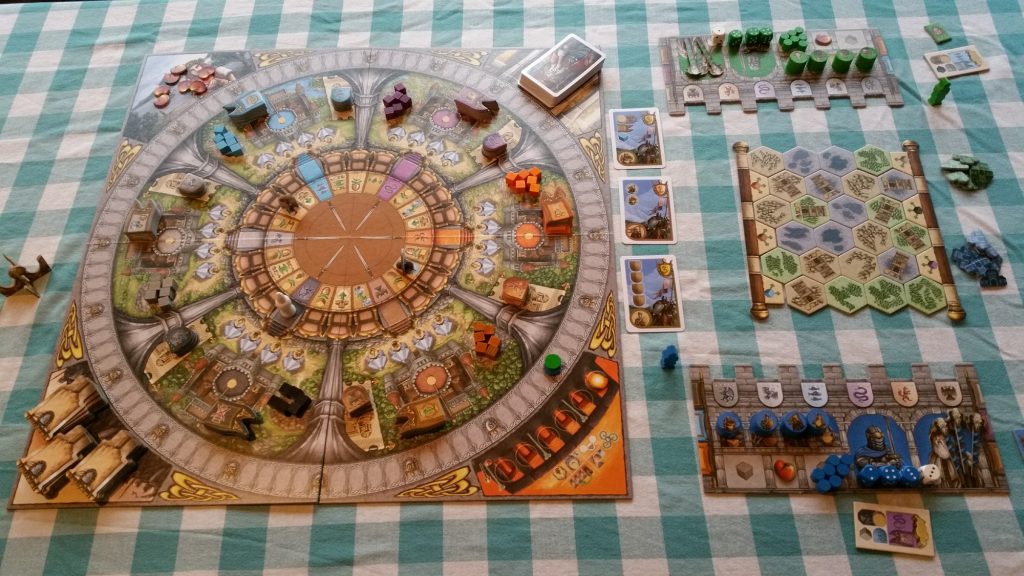
Any leftover apples are placed into their proper location on the game board. The Excalibur and Holy Grail standees are placed onto their locations of the rondel. The Merlin figure is placed on the black space in front of the black principality. The deck of Mission cards is shuffled and placed face down onto its spot and three cards are drawn and placed face up next to the deck. The traitor tiles are shuffled face down and placed into three stacks on their spot on the game board. After this is done, each player will be given three random traitors which will be placed into their locations on the castle boards. Then each player is dealt a hand of 4 mission cards. The round tracker token is placed onto the first spot of the round track and each player places their scoring marker onto the ‘0’ space of the scoring track. After all of this has been done a starting player is chosen and you’re ready to begin.
Anatomy of a Round
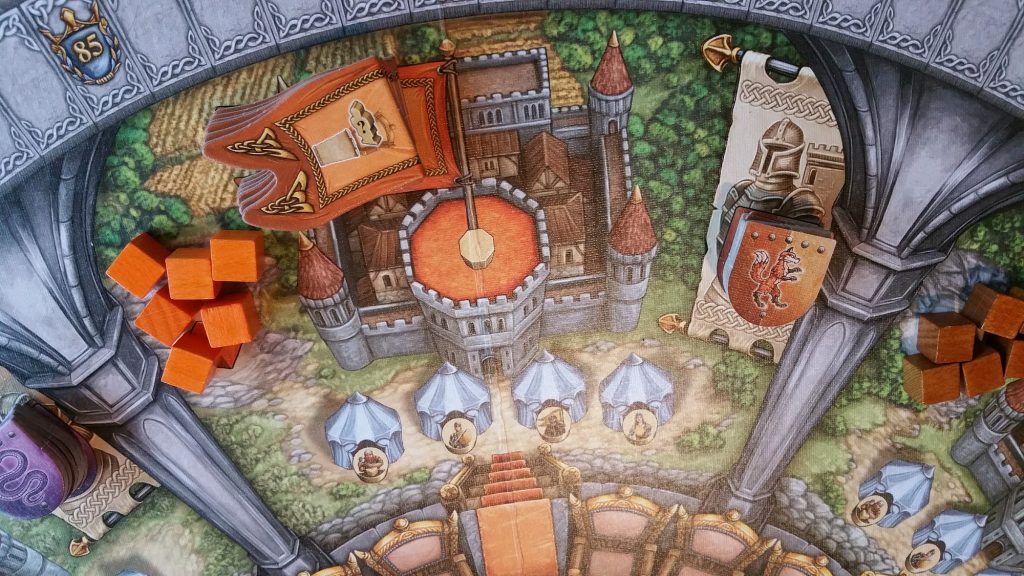
Merlin is played over a series of six rounds and each round consists of four turns. At the beginning of each round the players will roll all four of their dice and place them onto their castle boards. If any triples or quadruples are rolled, then all of the dice must be re-rolled until no triples or quadruples exist. Then, in turn order, players will take turns placing a die into the middle of the game board, moving their Knight figure the number of spaces, in a clockwise direction, dictated by the placed die and performing the action of whichever space they land on. If the placed die is the white die, then they will move the Merlin figure instead and this figure can be moved clockwise OR counterclockwise. Additionally, a player may discard one of their Merlin staves to perform their Merlin action a second a time.
Those are the basics. However, there are several methods in place for the players to adjust the dice values as well as change the way the pawns move across the board. In addition to performing their action the players may also complete a mission card from their hand if they are able.
Mitigation
There are several ways to mitigate the luck presented by the dice rolls in Merlin. They are:
- Discarding an apple allows the player to change a single die to any chosen face
- Discarding certain flags allows the player to flip dice to their opposite sides, use the actions of other players after they have already moved, move counterclockwise, or skip to the other side of the board
Each player begins the game with an apple, but the only way to obtain more of them as the game progresses is to land on the Holy Grail space. Flags are collected by utilizing the ability of the flagbearer henchman. Henchmen placement is key to doing well.
Henchmen
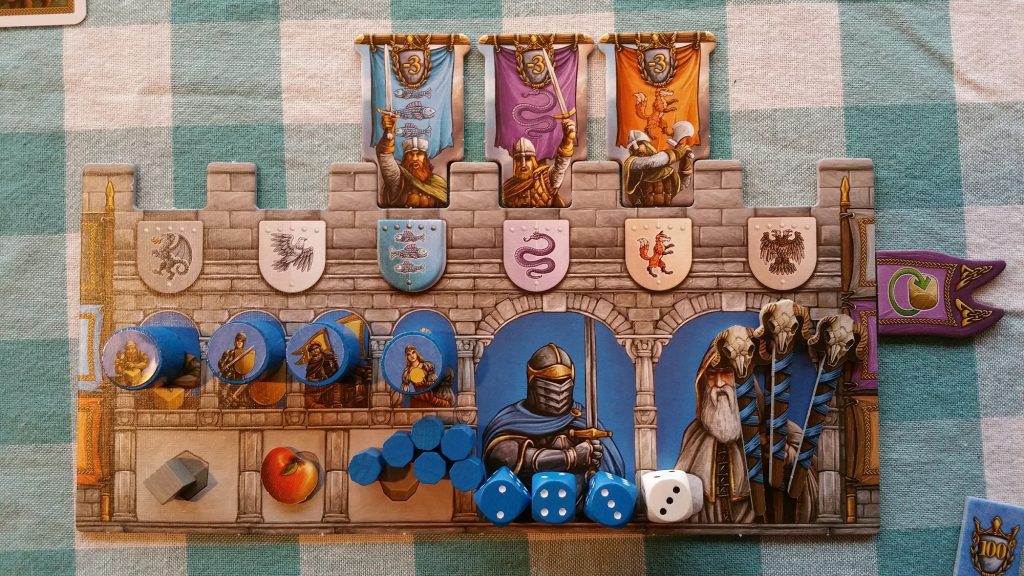
Each player has four different types of henchmen. These henchmen, when deployed to a principality, perform unique actions. The four different types and their actions are:
- The builder: allows the player to collect a construction material cube of the same color as the principality. These cubes are used to fulfill mission cards as well as to construct manors in the environs.
- The shield bearer: allows the player to collect a shield of the same color as the principality. These shields are used to fulfill missions cards as well as to repel traitors.
- The flag bearer: allows the player to collect a flag of the same color as the principality. These flags are used to fulfill missions cards and provide unique abilities when they are discarded.
- The lady in waiting: allows the player to place one of their influence cubes onto the tower of the principality. These influence cubes are used to fulfill mission cards and also come into play during the scoring rounds.
Mission Cards

Each mission card has the same layout. At the top right of the card is a shield with a number inside of it. This is how many victory points (VP) the card will be worth when it is completed. Along the left side of the card are the conditions that must be fulfilled in order to complete the mission. The items required only need to be present. Nothing needs to be returned to the supply in order to fulfill a mission. For example, the card shown here requires the player to have any four shields on their castle board. If they meet that condition, they will discard the card, score 3 VP, and then select a new card to replace the one that was just turned in. At the bottom left of the card is an image of one of the henchmen. This is only used in one of the included mini-expansions which I am not going to discuss here.
The Environs

The environs are laid out randomly at the beginning of every game. They are made up of several hexagonal tiles arranged into a pattern and these are sandwiched between two end pieces that contain pictures of the different construction material cubes with arrows pointing from them. The cube dictates the color of cube that must be discarded to build a manor and the arrows dictate where a manor may be built. In the example here, if a player were to discard a brown construction material cube, they could construct one of their manors on any of the spaces along the red lines as long as someone else didn’t already have a manor constructed there. If a manor is built on top of a tower, the player may collect a flag or a shield of their choice or they may place one of their influence cubes onto a tower in a principality of their choice. These manors also come into play during the scoring rounds.
The Rondel

Central to the game is the round table which the players will be moving their pawns around. In addition to the principality spaces which I have already touched upon, there are also spaces which provide other types of benefits such as allowing players to gain victory points for every type of a specific item that they have, spaces which allow the player to discard unwanted mission cards and replace them with new ones, spaces which allow the players to construct manors in the environs, spaces which allow players to acquire items based on the location of their influence cubes, and others. Additionally, one of the spaces will allow the player that lands there to take Excalibur into their possession. This provides an immediate benefit of allowing a player to repel all of the traitors of a single color from their castle board and it can also provide bonus points during scoring.
Scoring
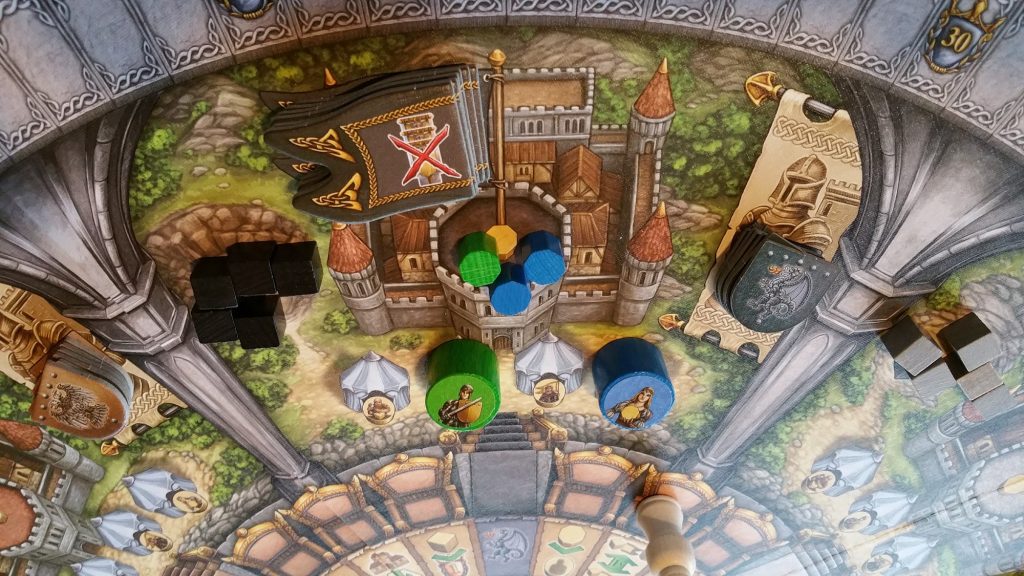
There are three scoring rounds during the course of the game, which occur at the end of rounds 2, 4, and 6, and one final scoring after that. The scoring rounds always follow the same sequence. First, the players must repel the traitors from their castle boards. This is accomplished by discarding a shield matching the color of the traitor. Any traitors that were not repelled will earn the player -3 VP. Then the traitors are removed and replaced with 3 new ones that are drawn at random. If the player holding Excalibur manages to repel all of the traitors from their castle board, they will receive 3 bonus VP.
Next, the environs are scored. The environs are broken up into different colored territories – blue, grey, and green. The size of a territory is equal to the number of same-colored tiles that are connected. If a player has more manors constructed in a territory than anyone else, they receive all of the points for that territory. If they share control of it, the points are split equally among the players, rounded down. In the example below, green would score 9 points and blue would score 6. While blue and green both have manors built in the same grey territory, blue has the majority and therefore scores all of the points.
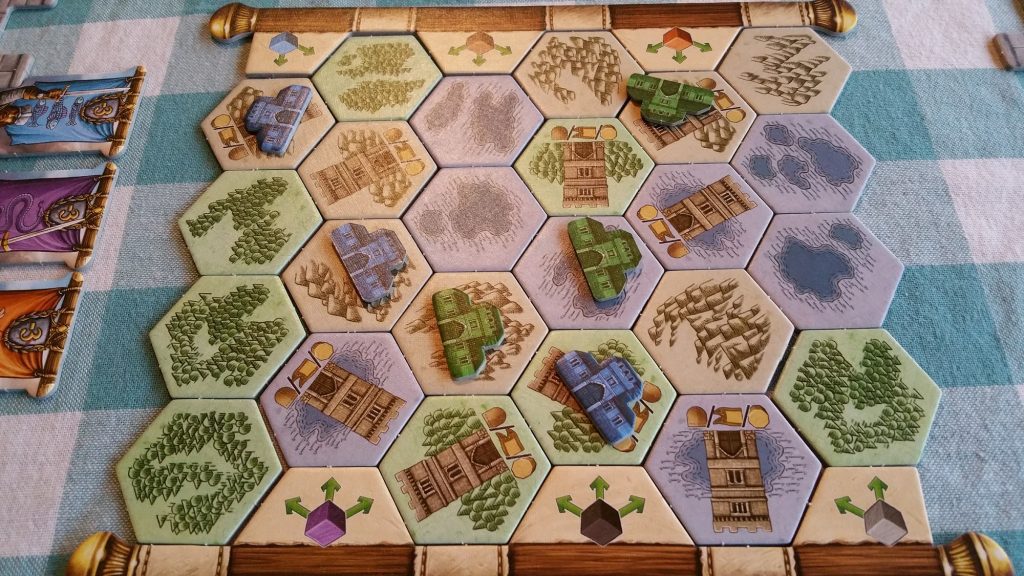
After this, influence is scored. Beginning with the black principality and moving clockwise around the board the influence cubes in each tower are added together and the player with the majority will score that many points. If there is a tie, just like the environs, the points are split equally. Then any towers that contain multiple cubes of the same color are reduced so that they only contain one cube of that color. If there is a tie and one of the players involved in that tie controls the Holy Grail, then they can use the grail to break the tie, but it can only be used once per scoring round. Finally, players will receive one point for each of their deployed henchmen. At the end of the game each player will receive 1 VP for each apple they have left, 2 VP for each Merlin staff that remains, and 1 VP for every 3 leftover resources (shields, cubes, and flags). The player with the most VP wins.
Thoughts
Before I delve too deeply into what I think of Merlin’s gameplay, I’d like to take a moment to talk about the components and the artwork. Queen Games’s titles always contain top-notch components. Merlin is no exception. The components in this game are everything that I would expect to find inside of a Queen game. The rulebook is laid out solidly and looks great. The card stock is nice and thick. The wooden components are well-crafted. It’s just a solid game as far as the components go.
Then there is Dennis Lohausen’s amazing artwork. Well known for being the artist of many other popular games (Fields of Arle, Aquasphere, Camel Up, and the new Gaia Project just to name a few), he brings his masterful skill to Merlin as well – and to good effect. The colors are bright and vivid. The illustrations are exquisitely detailed. This game is truly a feast for the eyes. Because of Dennis Lohausen, Merlin has a table presence that cannot be ignored. This is the type of game that gets people’s attention.
And then that interest will gradually wane. At least it has for me. If Merlin’s slippage from BGG’s Hotness List is any indicator, I am not alone. Here are the reasons why…
For many that are interested in this game, it is because we all share one thing in common. We are Stefan Feld fans. Castles of Burgundy. Trajan. Notre Dame. Amerigo. Stefan Feld is a designer that continually produces solid games that emphasize skillful play over random luck. Even when there is a healthy amount of chance involved, Feld typically gives the player some method of mitigating this. In Castles of Burgundy, for instance, a player can trade one of his or her dice to obtain worker tokens that can be used to add or subtract pips from other dice on future rolls.
Merlin is no different in this regard. There are a few ways of mitigating bad rolls or lousy card draws: apples, flags, and the board space that allows you to discard cards and draw replacements. But all of these things require you to actually land on a space that allows you to acquire the things that you need to make them work. You can only obtain apples (beyond the first one) IF you’ve landed on the holy grail. You can only obtain a flag IF you’ve landed on the correct principality space and IF you’re able to place your flag bearer there or IF you have managed to construct a manor on top of a tower space in the environs. You can only get rid of cards IF you’re able to actually complete them or IF you land on the board space that allows you to discard some cards and draw some new ones. That’s a lot of IFs and if the dice rolls are not coming up in your favor in a way that allows you to do any of the things that I just mentioned, then you’re pretty much screwed.
And this happens a lot in this game. I’ve been on both sides of the equation – things going my way and things going very poorly for me – and it wasn’t particularly pleasant either way. When you’re in the lead by a huge margin, it isn’t much fun because you know you’re not there due to anything you’ve personally done or any decisions that you’ve personally made. And it’s never fun to be trailing behind the leader by 20 or 30 points with no hope of ever catching up. I just wish there were a way for me to give up potential now for mitigation later. If Merlin allowed me to trash a die roll in order to gain mitigation on another roll, the game would be perfect, but it doesn’t exist. The game suffers as a result.
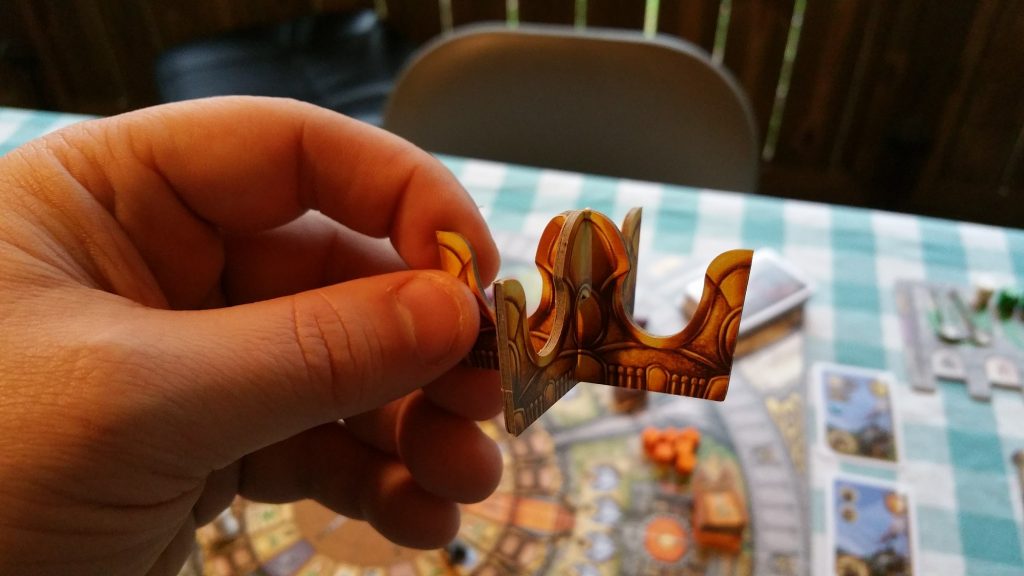
So, what can be done about the mitigation issue (assuming it’s as much of an issue for you as it is for me)? Well, the problem stems from the fact that your colored dice will always dictate your movement. Sans mitigation, regardless of which stops you make along the way, you will always wind up on the same space when all is said and done. If you roll a 2, a 3, and a 4, you will always have moved a total of 9 spaces regardless of which order you decided to use your dice to move. Yes, adding something to the game that would allow you to discard a die in order to gain a token that could be used to adjust the pips on dice in future turns would definitely work, BUT those components do not currently exist in the game.
Without altering the game by adding homebrewed components to it, the only solution that I can think of would be to institute a house rule that allows pawns to leap over other pawns if the space they would land on is already occupied. If you’ve ever played Lewis and Clark, you will be familiar with this rule. I feel like this would add some much needed tactics to the game. In Lewis and Clark (a game which is solely about movement and nothing else) this rule encourages you to consider how best to maximize your movement by using the fewest resources possible. Merlin desperately needs something similar.
And that’s not all. Despite the awesome artwork, Merlin doesn’t seem to be very thematically cohesive. The classic tale of King Arthur and Merlin contains a round table and the game contains a rondel that’s shaped like the round table. Aside from that, the game doesn’t really feel connected to the source material in any meaningful way. When I play it, I don’t feel like I am a knight at King Arthur’s table. In fact, King Arthur isn’t even present in the game at all.
There are times that I almost wished a eurogame had decided to just go the abstract route instead of pasting on a theme and this is definitely one of those times. If you’re in the market for a game about King Arthur and the Knights of the Round Table, you’re going to walk away from Merlin disappointed. There’s not much that you can do as a player about the thematic issues, but the issue of luck mitigation? That might be solvable.
Maybe things would be different if this were a pure Feld game as opposed to a designer team-up. Who knows? All I can say is that it pains me to admit that this is probably my least favorite Feld game. Am I sorry that I bought it? Definitely not. I’m not just a player. I’m a collector, too and I’m glad that Merlin is in my collection. But if I disconnect from that aspect of my personality, Merlin would honestly be a game I’d want to play once or twice and never revisit. As much as I REALLY want to love the game, it just isn’t very compelling… at least not for me. Maybe you like a little chaos in your games. If that’s the case, this is definitely the Feld game for you. Regardless, I would recommend you give the game a try at least once. It’s a good game, but it could have been a GREAT one.


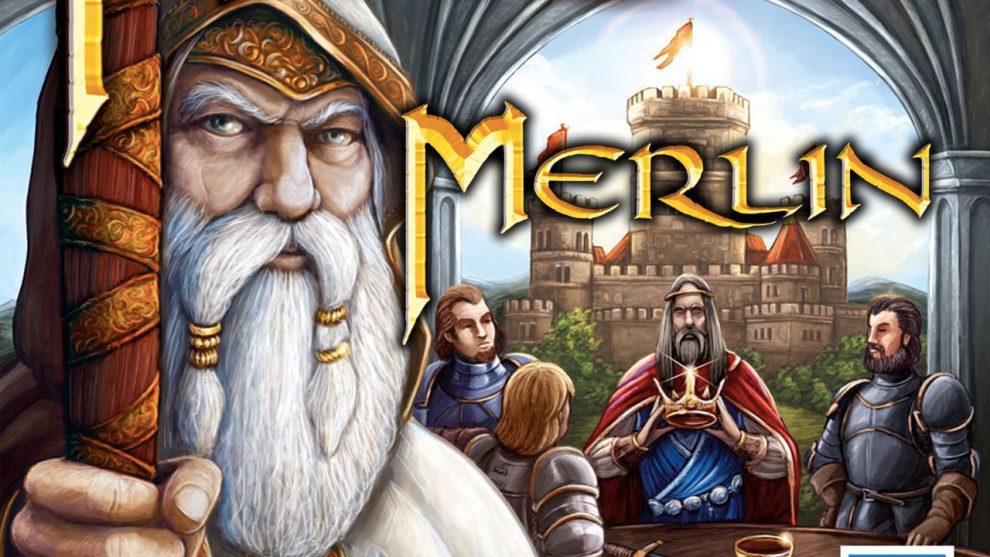









Add Comment